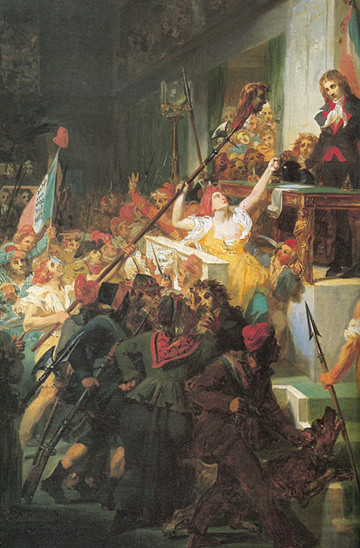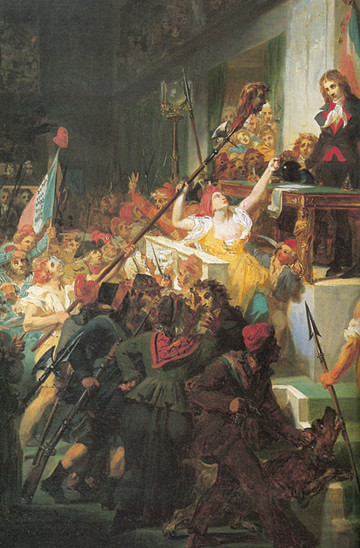#2November1795
Explore tagged Tumblr posts
Photo

Thermidorian Reaction
The Thermidorian Reaction refers to the period of the French Revolution (1789-1799) between the fall of Maximilien Robespierre on 27-28 July 1794 and the establishment of the French Directory on 2 November 1795. The Thermidorians abandoned radical Jacobin policies in favor of conservative ones, seeking the restoration of a stable constitutional government and economic liberalism.
The Thermidorians came to power by conspiring against and overthrowing Maximilien Robespierre (1758-1794). After his execution, the Thermidorian regime set about dismantling the Reign of Terror by purging the Jacobins from positions of power and by violently suppressing their ideology in the First White Terror. Their efforts to return stability to France resulted in pursuance of conservative policies reminiscent of earlier phases of the Revolution; they restored freedom of religion, reintroduced free market capitalism, and allowed the return of some aristocratic émigrés into France, leading to a rise in openly royalist sentiment. These policies were met with mixed success.
The new regime was generally unpopular with the French people, who faced increased rates of poverty and starvation during the 15 months of Thermidorian rule. This led to multiple attempted coups, the most significant of which was the Uprising of 1 Prairial Year III (20 May 1795), in which insurgents demanded bread and the adoption of the dormant constitution of 1793, which had been written by the Jacobins. After the uprising had petered out, the Thermidorians wrote their own constitution of Year III (1795), which established the French National Directory.
Thermidorians
The name 'Thermidorians', ascribed to the conspirators against the Robespierrist regime, is derived from the mid-summer month of Thermidor in the French Republican calendar, during which the coup took place. Though possessing a shared distaste for Robespierre, the Thermidorians had little else in common. Some of them had been willing and enthusiastic participants of the Terror before they had run afoul of Robespierre and needed to be rid of him to save their own skins. Others had detested the Terror from the start and had been eager to bring it down. Many were conservative republicans who represented the centrist mass of Convention deputies known as the 'Plain', who desired to turn back the clock to the way the Revolution had been in 1792, pre-Terror; others wished to go back further, seeking a second attempt at constitutional monarchy, as in 1791.
This lack of consensus, as well as the absence of dominating personalities to rally behind, contributed to the ineffectiveness and unpopularity of the Thermidorian Convention. The lackluster success of their policies has certainly marred the Thermidorians' legacy. Their detractors viewed them as an unremarkable interlude between Robespierre and Napoleon at best; at worst, they were the gravediggers of their own Revolution, one-time revolutionaries seduced and corrupted by the heights of power. This latter context was used by Leon Trotsky in his 1937 book The Revolution Betrayed, in which he refers to the rise of Joseph Stalin as a Soviet Thermidor.
While there may be elements of truth to these claims, historian Bronisław Baczko asserts that the Thermidorians were merely being realistic. The Revolution, having lost much of its momentum, grew closer to succumbing to fatigue with every month. It was becoming clearer that the Revolution could no longer live up to the promises made in 1789. Therefore, rather than willfully burying the Revolution, Baczko argues that the Thermidorians realized these limitations and simply did their best to work around them. After the violence of the Terror, many French people desired stability over revolutionary progress, which the Thermidorians attempted to give them. In either case, the period of the Thermidorian Reaction marked a counter-revolution of sorts, moving away from the radical progress of the Jacobins and back toward stable conservatism.
Continue reading...
23 notes
·
View notes
Photo

Thermidorian Reaction
The Thermidorian Reaction refers to the period of the French Revolution (1789-1799) between the fall of Maximilien Robespierre on 27-28 July 1794 and the establishment of the French Directory on 2 November 1795. The Thermidorians abandoned radical Jacobin policies in favor of conservative ones, seeking the restoration of a stable constitutional government and economic liberalism.
The Thermidorians came to power by conspiring against and overthrowing Maximilien Robespierre (1758-1794). After his execution, the Thermidorian regime set about dismantling the Reign of Terror by purging the Jacobins from positions of power and by violently suppressing their ideology in the First White Terror. Their efforts to return stability to France resulted in pursuance of conservative policies reminiscent of earlier phases of the Revolution; they restored freedom of religion, reintroduced free market capitalism, and allowed the return of some aristocratic émigrés into France, leading to a rise in openly royalist sentiment. These policies were met with mixed success.
The new regime was generally unpopular with the French people, who faced increased rates of poverty and starvation during the 15 months of Thermidorian rule. This led to multiple attempted coups, the most significant of which was the Uprising of 1 Prairial Year III (20 May 1795), in which insurgents demanded bread and the adoption of the dormant constitution of 1793, which had been written by the Jacobins. After the uprising had petered out, the Thermidorians wrote their own constitution of Year III (1795), which established the French National Directory.
Thermidorians
The name 'Thermidorians', ascribed to the conspirators against the Robespierrist regime, is derived from the mid-summer month of Thermidor in the French Republican calendar, during which the coup took place. Though possessing a shared distaste for Robespierre, the Thermidorians had little else in common. Some of them had been willing and enthusiastic participants of the Terror before they had run afoul of Robespierre and needed to be rid of him to save their own skins. Others had detested the Terror from the start and had been eager to bring it down. Many were conservative republicans who represented the centrist mass of Convention deputies known as the 'Plain', who desired to turn back the clock to the way the Revolution had been in 1792, pre-Terror; others wished to go back further, seeking a second attempt at constitutional monarchy, as in 1791.
This lack of consensus, as well as the absence of dominating personalities to rally behind, contributed to the ineffectiveness and unpopularity of the Thermidorian Convention. The lackluster success of their policies has certainly marred the Thermidorians' legacy. Their detractors viewed them as an unremarkable interlude between Robespierre and Napoleon at best; at worst, they were the gravediggers of their own Revolution, one-time revolutionaries seduced and corrupted by the heights of power. This latter context was used by Leon Trotsky in his 1937 book The Revolution Betrayed, in which he refers to the rise of Joseph Stalin as a Soviet Thermidor.
While there may be elements of truth to these claims, historian Bronisław Baczko asserts that the Thermidorians were merely being realistic. The Revolution, having lost much of its momentum, grew closer to succumbing to fatigue with every month. It was becoming clearer that the Revolution could no longer live up to the promises made in 1789. Therefore, rather than willfully burying the Revolution, Baczko argues that the Thermidorians realized these limitations and simply did their best to work around them. After the violence of the Terror, many French people desired stability over revolutionary progress, which the Thermidorians attempted to give them. In either case, the period of the Thermidorian Reaction marked a counter-revolution of sorts, moving away from the radical progress of the Jacobins and back toward stable conservatism.
Continue reading...
19 notes
·
View notes